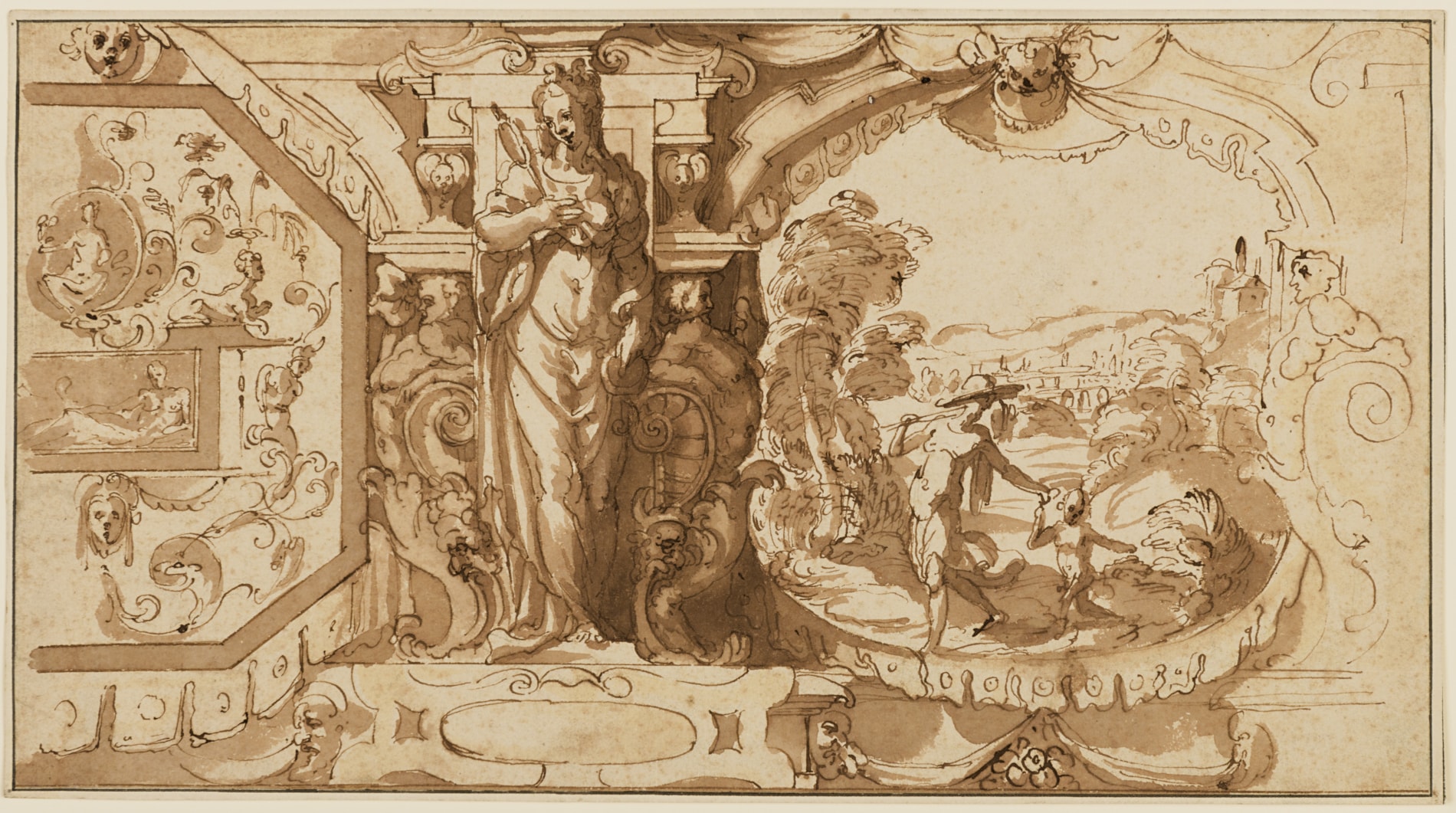Giovanni Battista CREMONINI
(Cento 1550 - Bologna 1610)
A Design for a Mural Decoration, with an Allegorical Female Figure of Prudence Flanked by Grotesques and a Painting of Two Figures in a Landscape
Sold
Pen and brown ink and brown wash, with framing lines in black ink.
Laid down.
174 x 319 mm. (6 7/8 x 12 1/2 in.)
Laid down.
174 x 319 mm. (6 7/8 x 12 1/2 in.)
A pen and wash drawing of a close variant of this composition by Giovanni Battista Cremonini, of similar dimensions to the present sheet and inscribed ‘Cremonino’ in a 16th or early 17th century hand, is in the Uffizi in Florence. The Uffizi drawing displays several minor differences with the present sheet, notably in the two walking figures in a landscape in the right-hand panel, as well as some of the flanking motifs. A stylistically comparable drawing for an ornamental frieze by Cremonini is also in the Uffizi.
Giovanni Battista Cremonini, sometimes called Zamboni, was an Emilian artist who was particularly known for the fresco decoration of numerous houses and churches in Bologna, where he spent most of his career. He was first trained by his father, the fresco painter Matteo Cremonini di Zanebone, and among his earliest works was a Deposition of Christ in the church of San Pietro in his native town of Cento, which is now in the Pinacoteca Comunale there. Cremonini completed his artistic education in Bologna, where in 1569 he received a commission to paint a secular frieze in the Palazzo Riario (now Sanguinetti), now lost, and he soon earned a reputation as a skilled and gifted decorator and quadraturista. In 1587 he began an extensive series of paintings and frescoes in the church and monastery complex of San Michele in Bosco, which occupied him for much of the next decade. An active member of the Compagnia dei Pittori in Bologna, Cremonini was commissioned in 1600 to paint frescoes in the circular church of the Madonna del Monte.
Cremonini earned numerous commissions throughout his career, and supervised an active and busy workshop. Among other prominent by the artist in Bologna – almost all of which are now lost or destroyed - were frescoes in the Ercolani, Fiorini, Lucchini, Montecalvi, Pietramellari and Samperi palaces and the façade of the Collegio di Spagna, as well as paintings in the churches of San Domenico, Santa Agnese, Santa Maria della Vita, San Giorgio, Santa Maria Mascarella, the Corpus Domini and the Scalzi, among several others. Cremonini is also known to have worked on ephemeral decorations at the courts of Modena and Parma. His last dated works are two frescoes in the convent church of San Francesco in Bologna, executed in 1604. Among Cremonini’s pupils were Odoardo Fialetti, Emilio Savonanzi, Francesco Gessi and, possibly, Guercino.
Cremonini earned numerous commissions throughout his career, and supervised an active and busy workshop. Among other prominent by the artist in Bologna – almost all of which are now lost or destroyed - were frescoes in the Ercolani, Fiorini, Lucchini, Montecalvi, Pietramellari and Samperi palaces and the façade of the Collegio di Spagna, as well as paintings in the churches of San Domenico, Santa Agnese, Santa Maria della Vita, San Giorgio, Santa Maria Mascarella, the Corpus Domini and the Scalzi, among several others. Cremonini is also known to have worked on ephemeral decorations at the courts of Modena and Parma. His last dated works are two frescoes in the convent church of San Francesco in Bologna, executed in 1604. Among Cremonini’s pupils were Odoardo Fialetti, Emilio Savonanzi, Francesco Gessi and, possibly, Guercino.




